Alnilam (ε Orionis) | Facts, Information, History & Definition (original) (raw)
Key Facts & Summary
- Alnilam is a bright blue supergiant located at around 1,975 light-years / 600 parsecs away from the Sun.
- Alnilam is a spectral type B0 la star. It has an apparent magnitude of 1.69. It is also a variable star of the Alpha Cygni class.
- Thus, its brightness varies from 1.64 to -1.74. Its absolute magnitude has been estimated to be around -6.89.
- Alnilam is around 537.000 times brighter than our Sun, and because of this brightness, it illuminates a molecular cloud, NGC 1990, that surrounds the star.
- Alnilam is more than 30 times bigger than our sun. It has around 40 solar masses and a radius of around 32.4 times that of the sun.
- Its powerful stellar winds reach speeds of up to 2.000 km / 1.242 mi per second. Because of this, Alnilam loses mass around 20 million times faster than the rate of the Sun’s mass loss.
- Alnilam is also quite a young star, having an estimated 5.7 million years – much younger than our sun.
- Alnilam is also a fast spinner, spinning at a rate of around 40 - 70 km / 24.8 - 43.4 mi per second.
- Alnilam is also much hotter than our sun, with estimated surface temperatures of around 27.500 K.
- Orion’s Belt is formed by three stars, Alnilam, Alnitak, and Mintaka. Alnilam is the star located in the middle of the asterism.
- The surface gravity of Alnilam has been estimated to be at around 3.0 cgs.
- Alnilam is the most massive and biggest star in Orion’s Belt. It is also the only star in this asterism which appears to be a single star. The other two stars have many more companions which are gravitationally bound to them.
- Alnilam / Epsilon Orionis - belongs to the Orion OB1 association.
Alnilam is the middle star that is part of the famous Orion’s Belt asterism. This asterism has been known for thousands of years and was associated with many myths and religious beliefs.
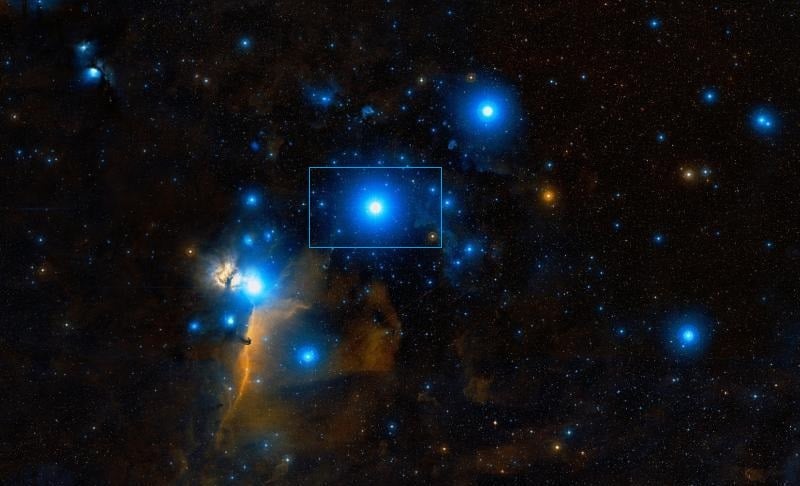
Alnilam is a word of Arabic origin that was derived, and roughly translates to “spring of pearls.” The traditional name was also alternatively spelled as Alnihan or Alnitam.
All three variants are evidently mistakes in transliteration or copy errors. Orion’s Belt itself was collectively known by many names in many cultures throughout the ages. The other two stars forming Orion’s Belt are Alnilam and Mintaka.
Formation
The constellation of Orion is home to many blue stars, clusters, nebulae, and clouds of dust and gas. Star formation is pretty active in this region. All the three stars in Orion’s Belt, for example, have many other companion stars around them, thus they form multiple star systems (with the exception of Alnilam).
Alnilam is the loneliest out of the stars forming Orion’s Belt. It also appears to be the youngest, at an estimated age of 5.7 million years. It is much younger than our sun, in fact, all the stars in Orion’s Belt are.

Alnilam – Epsilon Orionis –belongs to the Orion OB1 association in the subgroup OB1b which is part of the Orion Molecular Cloud Complex – a star-forming region with stellar ages ranging up to 12 million years old. Gas and dust from this molecular cloud, were pulled together by gravity and resulted in the many stars we now see in Orion, and thus Orion’s Belt.
Distance, Size, and Mass
Alnilam is located at around 1,975 light-years / 600 parsecs away from the Sun. Some estimates put it even farther or closer. Alnilam is also more than 30 times bigger than our sun. It is the biggest star in Orion’s Belt.
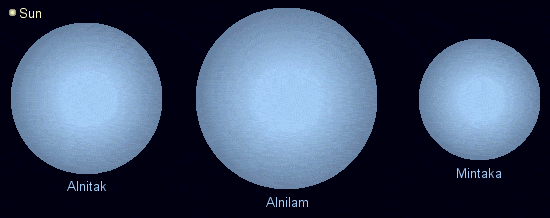
Alnilam is also the most massive star in Orion’s Belt. It has 40 times the mass of our Sun. Alnilam’s radius has been estimated to be around 32.4 times that of the sun.
Other Characteristics
Alnilam is a bright blue supergiant of spectral type B0 la. It has an apparent magnitude of 1.69, though it is also a variable star of the Alpha Cygni class. Thus, its brightness varies from 1.64 to -1.74. Its absolute magnitude has been estimated to be around -6.89.
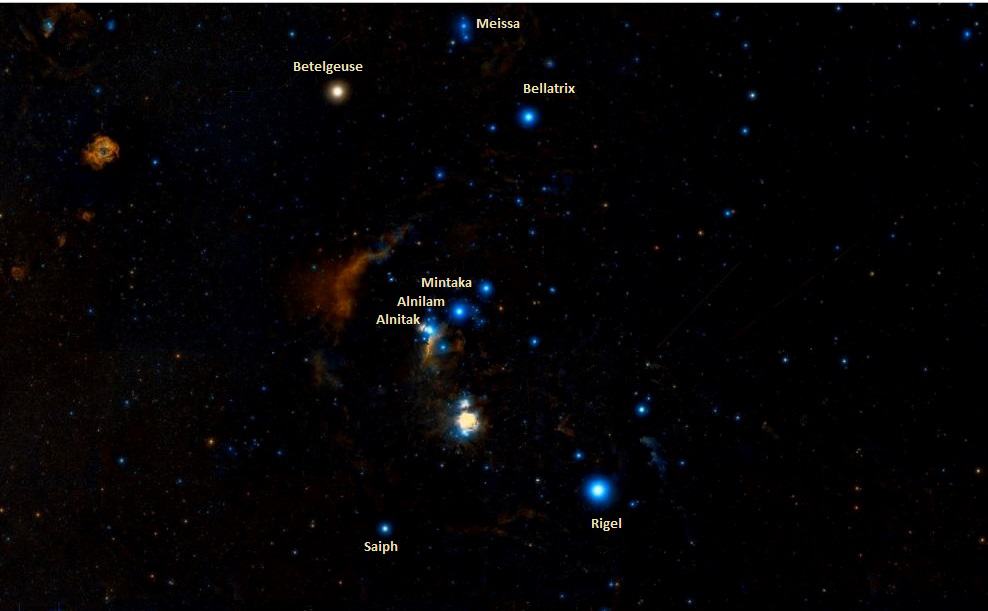
Alnilam is around 537.000 times brighter than our Sun, it is the brightest star of Orion’s Belt. Because of this brightness, it illuminates a molecular cloud, NGC 1990, that appears to have surrounded the star. Some different calculations put Alnilam at around 832.000 times more brighter than our sun. Observations continue to try and conclude this matter. Alnilam is quite a hot star, average surface temperatures have been estimated to be around 27.500 K. This means that Alnilam is around 4.7 times hotter than our sun.
Alnilam has powerful stellar winds that reach speeds of up to 2.000 km / 1.242 mi per second. Because of this, Alnilam loses mass around 20 million times faster than the rate of the Sun’s mass loss. Alnilam is also a fast spinner, spinning at a rate of around 40 - 70 km / 24.8 - 43.4 mi per second.
The star’s relatively simple spectrum has served since 1943 as a standard measure of which other stars are classified.
Location
Alnilam is located in the constellation of Orion, the celestial hunter. It is part of the three stars forming the hunter’s belt, being the star in the middle of the other two. Orion’s Belt is often used to search for the constellation itself.
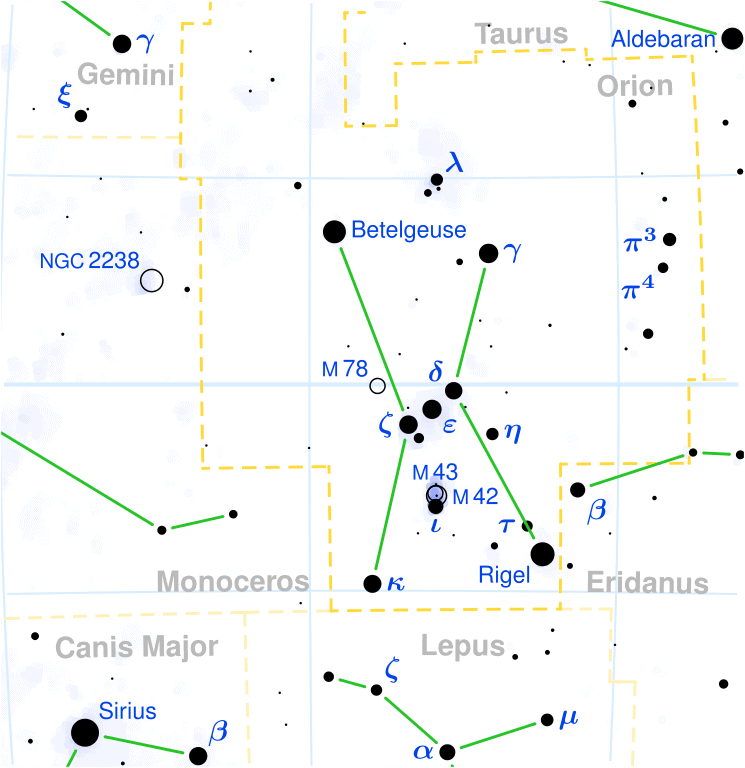
The constellation of Orion is also home to two first magnitude stars, Rigel and Betelgeuse, and it also hosts the nearest star formation region to Earth. This constellation is prominent in the sky for observers in the northern hemisphere during winter, and for observers in the southern hemisphere during summer. To southern observers, the constellation appears upside down.
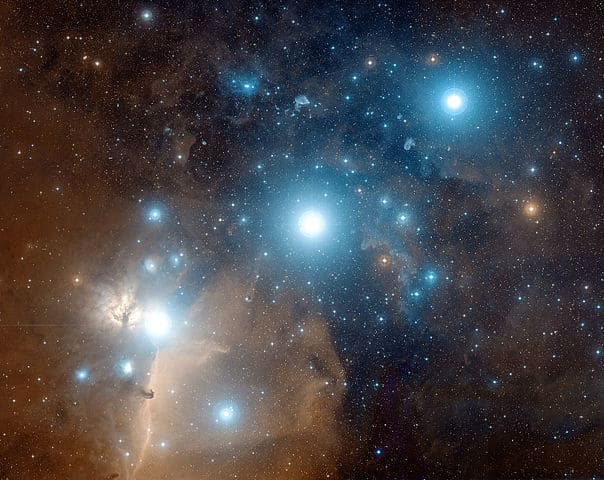
The Future
Since Alnilam is losing mass at such a high rate, and due to its size and other properties, the star is believed to be on its way to become a red supergiant in the near future. If this happens, Alnilam is expected to become a red supergiant even brighter than Betelgeuse. The star’s fate will inevitably reach a point in which it will explode as a supernova.
Did you know?
- Alnilam, together with Rigel, Betelgeuse, and Bellatrix, are part of the 58 stars selected for celestial navigation. Only the brightest stars and the ones which are the easiest to recognize are selected to be part of this group.
- For the Chinese, Orion’s Belt was known as Weighing Beam. This asterism contained the stars in the belt and also a couple more from the constellation. Alnilam was known as The Second Star of Three Stars
- The Egyptian gods Isis and Osiris were believed to have come from Orion’s Belt and Sirius to create mankind. Orion and Sirius were associated with these divine beings.
- The three pyramids on the Giza Plateau simulate the alignment of the three belt stars. The air shafts inside the pyramids point directly to the Orion constellation.
- Two large pyramids and a temple in Mexico were discovered to point directly at Orion’s belt as well. They were built in the 2nd century B.C. One of the pyramids is exactly half as tall as the Great Pyramid of Giza.
- The people of Puerto Rico and the Philippines, the three stars in Orion’s belt represented the three biblical Magi. They were named Tres Reyes Magos.
- In Finnish mythology, Orion’s belt is called Väinämöinen's Belt – a demigod, hero, and central character in the national epic Kalevala.
- In pre-Christian Scandinavia, the belt was known as Frigg’s Distaff or Freya’s Staff.
- In northwestern Mexico, the Seri people called the three belt stars Hapj – which is a name denoting a hunter
Sources:
Image source:
- https://www.star-facts.com/wp-content/uploads/2019/09/Alnilam.jpg
- https://upload.wikimedia.org/wikipedia/commons/thumb/4/47/Orion_Head_to_Toe.jpg/498px-Orion_Head_to_Toe.jpg
- https://steemitimages.com/p/HuuaCwcKuiEnqepZjxDXXTKn4RPSWhTQ8vaSsqWuhydKaBdc6SNNzNeRrWxMHsY4YBX?format=match&mode=fit
- https://www.star-facts.com/wp-content/uploads/2019/09/Orion-stars.jpg
- https://upload.wikimedia.org/wikipedia/commons/thumb/b/bf/Orion_constellation_map.svg/745px-Orion_constellation_map.svg.png
- https://upload.wikimedia.org/wikipedia/commons/thumb/4/4f/Orion_Belt.jpg/604px-Orion_Belt.jpg